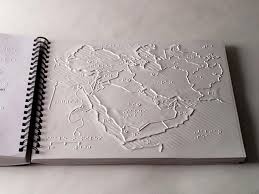Today, we exist in an increasingly digital day and age where everything is highly visual. We live our lives predominantly on our phones, computers, tablets all hooked up to some system of wifi connection. Education is now delivered through various forms of media such as projectors displaying power point, one note, education perfect and clickview (to name a few). Although this allows us to make the world smaller, it consequently makes life faster and more complex for students with a visual impairment. Assistive technology and visual aid tools are improving everyday for classroom use. While new technology and products are being released on a regular basis, it can often be accompanied with a high price. Until then, tactile graphics are the next best resource in providing information to students.
Students who are blind or visually impaired will require adaptations to access printed information that will allow the student to access all areas of the curriculum. It is the role of the Teacher of Students with Visual Impairments (TVI) to determine the adaptations that the student needs and to order or create these. Material adaptation needs will vary, depending on the degree of functional vision, effects of additional disabilities, and the task to be done. Students may use braille, large print, print with the use of optical devices, regular print, tactile symbols, a calendar system, sign language, and/or recorded materials to communicate.

Tactile Graphics
Students with a vision impairment are finding tactile graphics extremely valuable and, in some cases, vital for successful study, work and leisure. Routinely, students are provided with text transcribed into Braille, audio or large print. Pictures, diagrams and maps which accompany text are often excluded or only very briefly described in text.
Visual graphics can effectively be converted into tactile graphics, even when these visual graphics are high of detail or graphical information such as maps and scientific material. This is not simply a matter of taking a visual image and making some kind of tactile photocopy – the tactile resource requires a high level of knowledge and skill to be created effectively.
Visual graphics usually need to be considerably adjusted by specialists (like TVI's) in a variety of formats such as vacuum-formed (thermoform), swell paper (microcapsule paper) and embossed (such as that produced on a Braille printer). They can also be accompanied by labels and descriptions in Braille or audio format.
Tactile graphics are useful when:
the user is print-impaired but has some tactual ability
a concept not easily described in words
a real object is unavailable for touching
the shape, form or pattern is significant
it is necessary to illustrate scale and explain maps, technology or biological relationships
a one-time reference or reminder is needed
the educational experience can be enhanced.
Tactile graphics are not, however, exact replicas of the original. They also don't work well if a material has very fine detail or if it's being used to represent very large graphics. Creating these resources requires specialist training and access to particular support materials.
Tactile Collective Dream
At Tactile Collective, our dream is to provide teachers, families and students with educational tactile resources that enable students around the world to access the school curriculum. This will expand learning and knowledge of multiple concepts while allowing students to receive the same information as their classroom peers. We hope that by providing these resources and materials to all, we are also assisting teachers by decreasing their stress and content workload, and increasing their time in the classroom supporting students with visual impairments.
Image credits of tactile graphics to Perkinselearning.org, pathstoliteracy.org
#visualimpairments #tactilegraphics #teachersupport #inclusiveeducation #inclusion # viresources #tvi #visualimpairmentspecialist #visualspecialist #specialeducation #tactilecollective #adjustments #concepts #schoolenvironment #learning #curriculum #australiancurriculum #supportingteachers










Comments